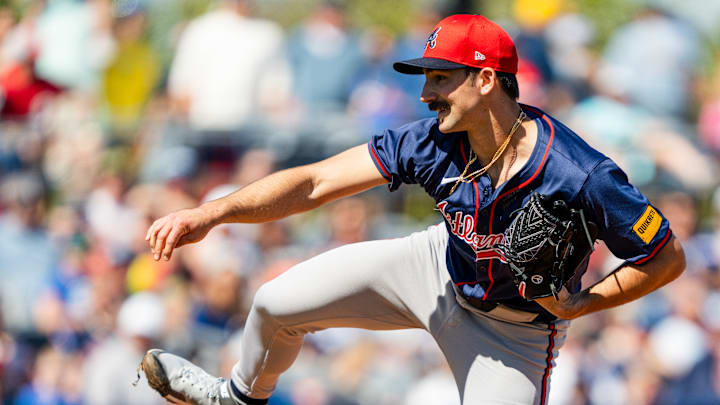Everything with Spencer Strider is meticulously calculated. The mustache is by design, as is the extensive stretching regiment for The Quadfather. While mechanics are everything for the third-year pro out of Clemson, the Atlanta Braves' fireballer needed to find a third pitch to lean on to help get more batters out. He has relied on the lethal fastball/slider combination over the last two seasons.
While he hinted at a new pitch in his arsenal only a few weeks ago, one that was not going to be a changeup, we had no idea it would be a hard-biting curveball. Strider said previously that he might still throw the changeup on occasion, but that it is kind of topped out at what it is due to his tight mechanics. Randy Johnson kind of had one to complement his slider and fastball in his great career.
Although I speculated that Strider was about to unleash either a splitter or a sinker this year, once again, I was wrong. The curveball is not as popular at the big-league level as it had been decades prior, but a well-located one can do wonders for a pitcher's repertoire. Clayton Kershaw made a hall-of-fame career of it out in Los Angeles. Even Strider's teammate Max Fried has a filthy one of his own.
Here is what Strider's new pitch looks like, as he struck out this Minnesota Twin during spring training.
Spencer Strider with his new curveball for the strikeout pic.twitter.com/Qr9Dzn2BMp
— Gaurav (@gvedak) February 29, 2024
It may not solve all of his issues as a starting pitcher, but having a third pitch to worry about will help.
Spencer Strider's curveball makes him an even better starting pitcher
In Strider's philosophical approach to pitching, he values velocity over location because great speed slows down reaction time. Simply put, if a pitch is fast enough, it really doesn't matter where it is located. Close only counts in horseshoes and hand grenades, but that might apply with 98 MPH fastball location as well. Although a curveball does have downward trajectory, this is all about timing.
In time, Strider may develop a splitter to get more guys to swing over the top of his offerings, or a sinker to induce more groundballs to get out of more innings quicker. However, having a third pitch with great command means the opposition will have to account for it at the plate. Rather than having to essentially guess if it will be fastball or slider, they will now have to prepare for Uncle Charlie, too.
Ultimately, the development of this curveball can serve Strider in the end. If he doesn't have great command of one of his three pitches in a given start, well, he now has two. That wasn't the case during his first two years in the league. Being able to develop and grow as a pitcher, as opposed to a thrower, will give him tremendous staying power in the Atlanta starting rotation for seasons to come.
We have not seen the best of Strider as a big-league pitcher; we are only just getting started here.
